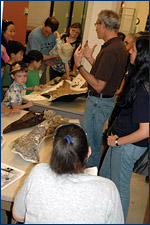

Perfect weather attracts record Cal Day crowds
 |
 |
||
|
Left: The fine weather brought out the crowds. Right: Mark Goodwin talks about fossil vertebrates during a tour of the collections. Click on any photo on this page to see an enlargement. |
|||
This year marked a change in UCMP's repertoire of regular activities. The always popular "Fun with Fossils" activity, in which children, young and old, could look for Cretaceous microfossils, was replaced with something completely new: "UCMP's Fossils Roadshow." Pre-Cal Day advertising on Berkeley's online calendar encouraged Cal Day visitors to bring their fossils by the Roadshow table for identification. So, stationed under the Berkeley Natural History Museum's tent out on the lawn south of VLSB, graduate students Jann Vendetti and Susumu Tomiya, and Professor Jere Lipps, did their best to put names and ages on the fossils (or in some cases, rocks) that people had found. Even if they did not have fossils with them, many people stopped at the table simply to talk about paleontology. The Roadshow was a hit and will definitely be back next year, so dust off those fossils and come see us on Cal Day 2009.
As usual, most of UCMP's activities were centered around the T. rex mount. Just behind T. rex, in the Museum proper, was the largest display: "The California Coast — Past, Present, and Future." With fossils, common living marine organisms, and posters, the focus was on biodiversity and the changing California coastline over the past 20 million years, and what we might expect to see should global warming result in a rise in sea level. Professor Jere Lipps gave a morning lecture with this same theme.
Two other displays, besieged by the fossil-loving populace all day long, were out in the atrium on opposite sides of the T. rex. At one, graduate student Randy Irmis traced the path of a fossil from its discovery to its use in instruction, with his work at quarries in New Mexico serving as the example (read more about Randy's field work). The other display featured fossils from famous localities in southern California.
And then there were two of UCMP's most popular Cal Day traditions: tours and t-shirts. UCMP's Museum Scientists led several groups of the curious through the normally closed-to-the-public research collections while the outreach unit offered up UCMP t-shirts with both old and new designs. This year's t-shirts featured Pteranodon and radiolarians. Next year, by popular demand, we'll be bringing back T. rex … and maybe a fossil plant.
All photos by Pat Holroyd, © 2008 UCMP.